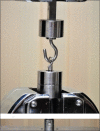An in vitro study to compare the influence of newer luting cements on retention of cement-retained implant-supported prosthesis
- PMID: 31040551
- PMCID: PMC6482622
- DOI: 10.4103/jips.jips_235_18
An in vitro study to compare the influence of newer luting cements on retention of cement-retained implant-supported prosthesis
Abstract
Purpose: The study was conducted to evaluate the retentiveness of specifically formulated implant cements and compare its retentiveness with a commonly used noneugenol zinc oxide luting cement and also to assess the influence of abutment height on the retentiveness of these cements.
Materials and methods: A master stainless steel mold was used to mount snappy abutment-implant analog complex in acrylic resin. A total of six snappy abutments (Nobel Biocare®) of 4 mm and 5.5 mm height with their analogs were used. A total of 66 ceramill® Sintron metal copings fabricated using computer-aided design/computer-aided manufacturing system and divided into six groups (n = 11) according to the height (three 4 mm abutment and three 5.5 mm abutment). The cements that were compared were a Noneugenol zinc oxide provisional cement (Temp-Bond™ NE), a Noneugenol temporary resin cement (Premier® Implant Cement) and a resin based acrylic urethane cement (Implalute® Implant Cement). After cementation samples were immersed in artificial saliva for 7 days and subjected to a pull-out test using a universal testing machine at a crosshead speed of 1 mm/min. The load required to de-cement each coping was recorded and analyzed using one-way ANOVA, post hoc multiple comparison, and independent t-test.
Results: Noneugenol temporary resin cement had the highest tensile strength followed by noneugenol zinc oxide cement and the least retentive strength was observed in resin-based acrylic urethane cement.
Conclusion: The results suggest that noneugenol temporary resin cement may be considered as a better choice for cementation of implant prosthesis, as it has shown to have better mechanical properties.
Keywords: Acrylic urethane cement; implant luting cements; resin-based temporary cement; tensile strength.
Conflict of interest statement
There are no conflicts of interest.
Figures






References
-
- Manawar A, Dhanasekar B, Aparna IN, Naim H. Factors influencing success of cement versus screw-retained implant restorations: A clinical review. J Osseointegration. 2012;4:43–7.
-
- Singer A, Serfaty V. Cement-retained implant-supported fixed partial dentures: A 6-month to 3-year follow-up. Int J Oral Maxillofac Implants. 1996;11:645–9. - PubMed
-
- Chee W, Jivraj S. Screw versus cemented implant supported restorations. Br Dent J. 2006;201:501–7. - PubMed
-
- Michalakis KX, Hirayama H, Garefis PD. Cement-retained versus screw-retained implant restorations: A critical review. Int J Oral Maxillofac Implants. 2003;18:719–28. - PubMed
-
- Hebel KS, Gajjar RC. Cement-retained versus screw-retained implant restorations: Achieving optimal occlusion and esthetics in implant dentistry. J Prosthet Dent. 1997;77:28–35. - PubMed
LinkOut - more resources
Full Text Sources
